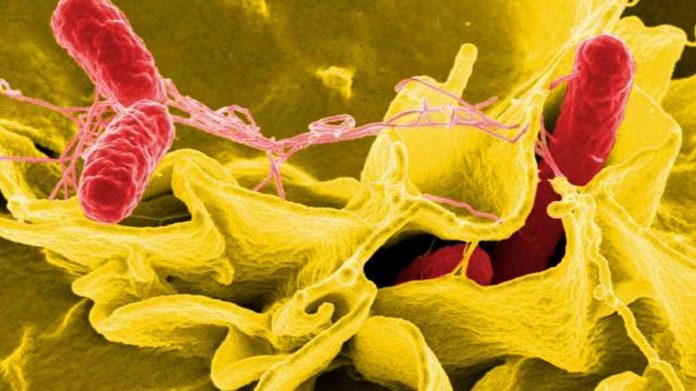Predatory bacteria, capable of invading and consuming harmful bugs such as E .coli and Salmonella, use a unique tool to help them escape the cell they have invaded without harming themselves, according to a new study.
Researchers at the Universities of Birmingham and Nottingham have identified a particular enzyme used by the bacteria to rupture the cell wall of its prey bacteria and exit without damaging its own cell wall. Their findings are published in Nature Communications.
The bacterium, called Bdellovibrio bacteriovorus, is important because the types of cells they attack – Gram negative bacteria – are responsible for many infections that are resistant to currently available antibiotics. This means predatory bacteria could have the potential to be harnessed as a therapy against these infections.
Discovering precisely how Bdellovibrio bacteriovorus succeeds in invading, and then escaping its prey cells is an important step in this process.
The enzyme they discovered seems like a well-known enzyme called a lysozyme- one of the earliest- ever studied enzymes and found in human tears and saliva; but this one has a twist where it has changed to do something surprising.
“Bdellovibrio bacteriovorus is known for its ability to invade prey bacteria and stay inside the cell for a few hours, effectively eating the bacteria alive,” explains Dr Andrew Lovering, of the University of Birmingham’s School of Biosciences. “At the end of this process, the predator is able to break the prey open and escape. Because the walls of both the predator and prey cells are made of very similar molecules, we wanted to find out how the predator was able to cut the cell wall material of the prey cell and get out without damaging itself in the process.”
The team already knew part of the answer lay in an early action by the predator bacteria to remove a particular molecule, from the cell wall of the prey. This created a ‘marker’ identifying the prey wall material as different to the predator. This suggested subsequent action by a particular type of enzyme known as a lysozyme might be at work. Lysozymes are a family of enzymes which are known to play a role in the breakdown of cell walls of certain bacteria. This particular lysozyme had evolved and been changed in the predatory bacterium to take on the task of rupturing the uniquely modified cell wall to enable the escape to take place.
Identifying precisely which lysozyme had been diversified for this role was the result of painstaking work by PhD students Hannah Somers and Chris Harding, working with Swiss National Science Foundation Fellow Dr Simona Huwiler.
Professor Liz Sockett, from the University of Notttingham’s School of Life Sciences and co-lead author of the paper, said: “Checking the timing of when the Bdellovibrio used each of its lysozymes in predation, and hours at the microscope seeing what happened to prey-escape when each lysozyme was missing, gave us strong hunch which might be the important one for escape.”
“When we looked closely at the lysozyme it was clear we were on the right path,” says Dr Lovering. “It looked like a conventional lysozyme but with a warped active site, which meant it was unable to recognise the wall material unless it had been modified and marked by the Bdellovibrio bacteria.”
The next step was to confirm that the lysozyme was only active against the modified cell wall and the team worked with Dr Patrick Moynihan, also in the School of Biosciences at the University of Birmingham, on tests to verify this. This showed it to be a novel lysozyme with a different target to all those lysozymes previously studied in science.
Dr Simona Huwiler, in Professor Sockett’s lab then carried out a series of experiments with the predator bacteria showing clearly how adding this novel lysozyme during the predation process led to the predator falling out from the prey cell early before finishing its meal. So the novel lysozyme is the key to exit.
“Understanding the mechanism and actions of this novel lysozyme may help us use it directly against pathogens which modify their own cell walls to resist the lysozymes in saliva and tears. It is is also an important step towards being able to use predatory bacteria themselves in new therapies against problematic bacteria,” adds Professor Sockett.




